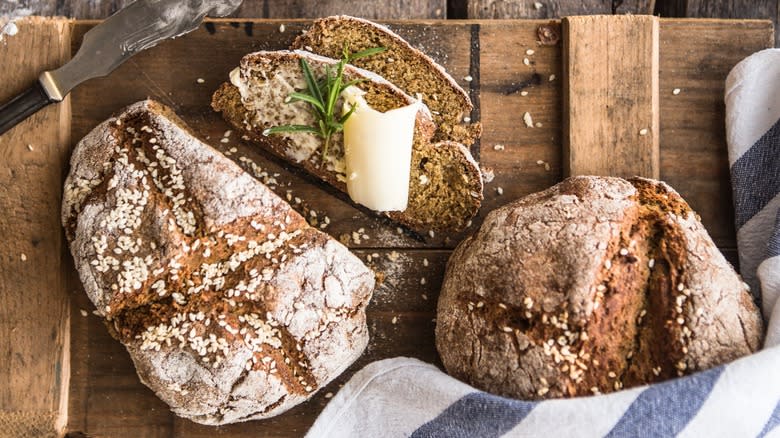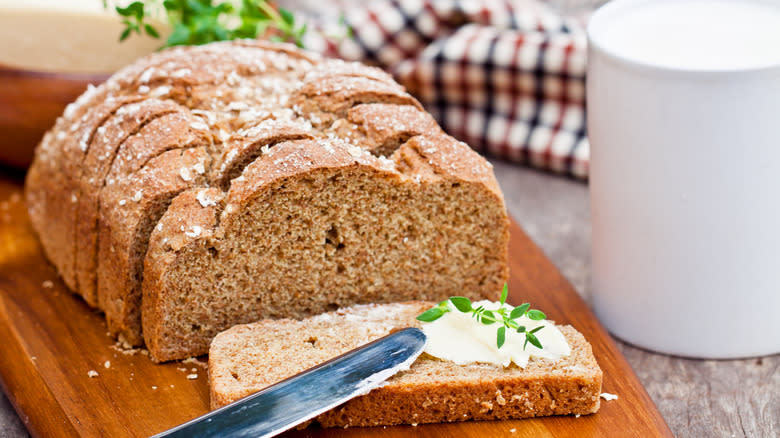The Rustic Difference Between Irish Soda Bread And Brown Bread

Bread has a vast, varied, and important history in Irish culture. Along with potatoes, bread was a staple of many Irish people's diets for hundreds of years, sustaining them during long journeys and in times of extreme hardship. As a result, there are many types of bread that are unique to Irish cuisine, some of which have gained popularity in kitchens around the world. Two of these are Irish soda bread and Irish brown bread. Despite their similar names, these breads are fairly different. The main distinction is the difference in these breads' ingredients, which in turn results in quite distinct flavors and textures. If such traits have piqued your interest, or if you are simply looking to expand your go-to bread repertoire, read further to join us on a deep dive into the world of these two celebrated breads and what exactly it is that makes them so special.
Read more: 30 Types Of Cake, Explained
What Is Irish Soda Bread?

Irish soda bread is a simple, lightly-colored bread that is enjoyed throughout Ireland both in everyday dining and during holiday celebrations like St. Patrick's Day. Originally invented by the indigenous peoples of North America, soda bread came about in Ireland in the early 1800s when baking soda became available. It acted as a solution to episodes of ingredient scarcity and also as a budget-friendly way to bake bread. The primary ingredient missing in these cases was often yeast. Yeast is far and away the most common leavening agent in bread baking, as the carbon dioxide gas created by the yeast is extremely effective in causing bread dough to rise. Since yeast was often not readily available or very affordable, Irish bakers instead combined buttermilk and baking soda into the dough. The reaction between these two ingredients also creates carbon dioxide, and so this technique is what allows the soda bread to rise. American versions of this bread sometimes add raisins or seeds, but this is not typical in Ireland.
What Is Irish Brown Bread?

Irish brown bread is a staple in Ireland the same way white bread is thought to be a staple in American kitchens. It is extremely versatile and can be used at any meal, or even as a snack. It employs the same leavening method as Irish soda bread, with buttermilk and baking soda creating the carbon dioxide needed for the dough to rise. It is no surprise, then, that it gained popularity around the same time. The bread is, as its name suggests, a beautiful deep brown color. It is also known to come in a variety of shapes depending on the region in which it is produced. The shape that is most commonly seen is its Southern Irish format, which is a round loaf with a cross cut into the top, as they do with soda bread. There are several theories about this practice but, depending on the source, it is either a superstition deriving from Irish folklore or an act of religious symbolism.
Irish Soda Bread Is Made With Just One Flour

The primary difference between Irish soda bread and Irish brown bread is the ingredients that go into making them. While there is some overlap — the buttermilk and baking soda, in particular — the two recipes diverge from there. Most notable is the selection of flour. Irish soda bread uses only one type of flour in its dough, usually white. Meanwhile, Irish brown bread uses wheat flour and bran in addition to white flour. The brown bread also incorporates several extra ingredients beyond the basic, including molasses and sometimes oats. These added ingredients significantly change the outcome of the end product, which is why Irish soda bread and Irish brown bread look different — the first being pale and the other being dark. These ingredients also contribute to the breads having slightly different flavors; while both are on the slightly sweeter side for bread, Irish brown bread tends to have a richer, nuttier flavor thanks to whole wheat and molasses.
Irish Brown Bread Is Chewy And Dense

Another key distinction between these breads is the texture each possesses. Irish soda bread, with its simple ingredients and low moisture, yields a crumbly texture with a hard crust, like that of an English scone. As such it is perfect for enjoying in a similar way to scones — often with honey or jam, or alongside a hot beverage like tea. On the other hand, Irish brown bread has a much more traditional bread-like texture. It has a dense but soft and spongy interior with a firm crust. The addition of molasses to the dough also makes it quite a bit more moist than Irish soda bread. This hearty bread is great for making toast, dipping in soup, or serving up as a side to a main dish. From an American culinary perspective, one might consider the texture of Irish soda bread to be more in line with breakfast food, whereas the texture of Irish brown bread better suits lunch and dinner purposes as a tasty buttered carb on the side.
Read the original article on Tasting Table.

